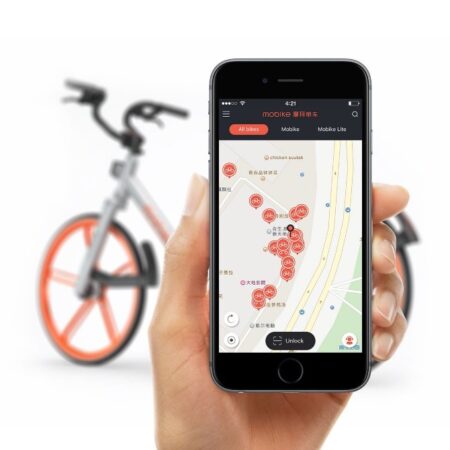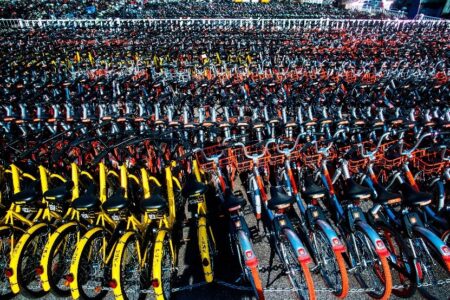Working at Foursquare ITP has given me the opportunity to work with people who are extremely knowledgeable and passionate about bikeshare. Since Capital Bikeshare arrived in my hometown, Washington, D.C., in 2010, I have been excited to both use the system and follow its progress as it expands across the region.
Nationally, bike share has expanded rapidly across the United States, increasing from one system in 2010 to over a hundred today. The bike share industry is not only rapidly growing, but continuing to evolve as modern technologies and companies drive innovation. One emerging model for bike share that promises to drastically change the face of the industry is dockless bike share.

(1) Dockless bike share systems resemble established systems like Capital Bikeshare or CitiBike, but have one major difference: instead of the computer and locking mechanism residing in the bike share station, these components are integrated into the bike itself. This design negates the need for bike share stations, typically the most expensive piece of equipment in a bike share system. Liberated from the need for stations, users can pick up or drop-off a bicycle anywhere within a delineated service area. Riders use a mobile app to locate, unlock and lock bikes.
While dockless systems have been around for a while, a new slate of companies using dockless technology, such as Limebike, Mobike, Ofo, are beginning to shake-up the bike share industry. What makes these start-ups different is that they claim to operate without any public assistance. This new model for bikeshare mimics the private-sector led business model of rideshare companies like Uber, or car sharing services like Zipcar. While private dockless systems promise to make bike share more accessible and ubiquitous, they also pose new challenges for the communities they serve.
The most prominent strength of dockless bike share is flexibility. Customers are freer to travel wherever they please when using a bike, provided the location is within the system’s delineated service area. This means that riders can use the system in areas that are not a part of a traditional “docked” bike share network, which benefits residents of neighborhoods that lack the demand to warrant a bike share station, such as those without businesses or restaurants. Dockless bikes are also improving access to areas that currently lack good transit service. Dockless systems also provide cities and other municipalities with valuable ridership data that existing bike share stations cannot. (2) Although certain docked bike share systems allow effective data collection, new dockless systems can see where riders are traveling to and from and what routes they are using. This helps when planning new bike paths or updating infrastructure like roads, sidewalks, bus stops, and bus routes. While bike share systems must be careful to ensure the data remains anonymous, there are benefits to community planning that can be achieved with the help of bike share data.

(3) No country has been more impacted by the new bike share companies than China, which is the home of many dockless bike share companies and their first testing ground. In what was once described as the kingdom of bicycles, the new bike share systems are proving to be a tremendous success, with enormous ridership in multiple cities. Some challenges include difficulty maneuvering through a sea of bikes to enter busy areas, such as subway stations or shopping malls, which has become a common occurrence for residents of Chinese cities. (4) Other residents have reported seas of abandoned bicycles, which take up space and provide more obstacles for pedestrians. Cities in the United States have so far avoided this problem by capping the number of bikes included in each system.
The systems themselves, both in China and in other countries, have relatively little ability to effectively ensure that users do not park their bikes in areas that are inconvenient for other cyclists or pedestrians. Some apps allow users to rate the previous rider’s parking job and submit pictures, with in-app credits as incentives, but more public education or enforcement may be required. Cities may want to designate specific zones, such as one or two parking spaces, on each block for users to park their bikes to help mitigate this problem. (5) While some may see this as simply another “dock” that would defeat the purpose of the dockless system, cities could implement these regulations in areas that are more crowded, like city centers. Buildings in these areas are usually more tightly clustered, and policymakers could designate locations around high-use destinations, such as stores, restaurants, or offices for dockless bike share parking. This could prevent pedestrian access problems in high-volume areas while still ensuring that the systems are effective in more residential or suburban areas.

Docked bike share systems typically rebalance bikes daily to ensure that they are in locations where they will be used, and to avoid the problem of empty docks. This will be more challenging for dockless systems, which currently rely on riders to do the rebalancing for them. In Washington, DC, I’ve noticed two new dockless bikes that were left outside an apartment building at the bottom of a large valley. These bikes remained there for at least a week unused. While this is an extreme case, it is indicative of the challenges that these systems will need to address, especially as they expand into more suburban areas. If companies are paying more employees to help with bicycle adjustment, this could result in subsidies for cities or higher premiums for users to help offset these costs. Rebalancing will also be needed to ensure that bikes are in low-income areas, which may not have stores or restaurants that would generate the trips needed to bring bikes to the area.(6)
While there are certain cautionary tales from dockless bike share systems in China and the U.S., the willingness of cities to welcome the new companies into their transportation networks shows a willingness to work collaboratively in the future, which will be vital to the success of dockless bike share in American cities. The challenge for cities is how to properly regulate these systems. If there are too few regulations, residents could become used to seeing the “bicycle graveyards,” that have popped up in many Chinese cities. (7) Conversely, too many regulations, may deter these firms from expanding. By working together to develop effective policies, municipalities and bike share companies can introduce a valuable component to transportation networks of cities across the country. I hope that as the leader in dockless bikeshare in the U.S., Washington, D.C. can successfully implement a dockless system that will improve transit access right in my backyard.
(1) Image courtesy of https://www.drivesweden.net/sites/default/files/content/u2175/mobo.jpg
(3) Image courtesy of http://fortune.com/2017/11/21/china-innovation-dji/
(4) https://www.theguardian.com/cities/2017/mar/22/bike-wars-dockless-china-millions-bicycles-hangzhou
(5) http://www.governing.com/gov-dockless-bikeshare.html
(6) Image courtesy of https://upload.wikimedia.org/wikipedia/commons/5/5b/Capital_Bikeshare_van_–_07-11-2012.JPG
(7) https://slate.com/business/2017/12/dock-less-bike-share-is-ready-to-take-over-u-s-cities.html